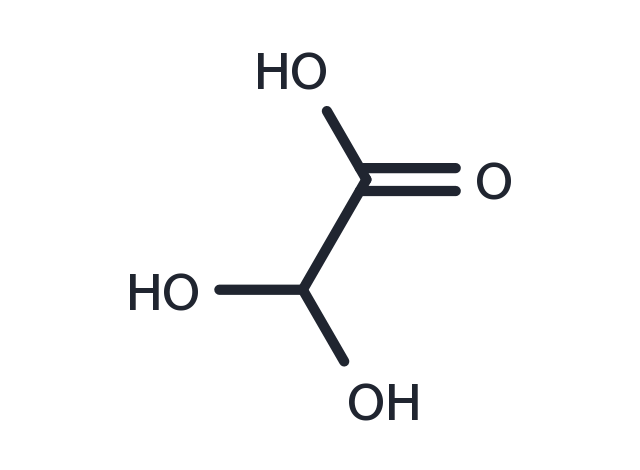Powder: -20°C for 3 years | In solvent: -80°C for 1 year


2,2-Dihydroxyacetic acid (Formylformic acid) is an intermediate in the glyoxalate cycle, which enables certain organisms to convert fatty acids to carbohydrates.2,2-Dihydroxyacetic acid has been found to be associated with primary hyperoxaluria, an inborn error of metabolism. As an aldehyde, glyoxalate is also highly active and can modify proteins to form advanced glycosylation products (AGEs).

| Pack Size | Availability | Price/USD | Quantity |
|---|---|---|---|
| 1 g | In stock | $ 29.00 | |
| 5 g | In stock | $ 47.00 | |
| 10 g | In stock | $ 68.00 | |
| 1 mL * 10 mM (in DMSO) | In stock | $ 43.00 |


| Description | 2,2-Dihydroxyacetic acid (Formylformic acid) is an intermediate in the glyoxalate cycle, which enables certain organisms to convert fatty acids to carbohydrates.2,2-Dihydroxyacetic acid has been found to be associated with primary hyperoxaluria, an inborn error of metabolism. As an aldehyde, glyoxalate is also highly active and can modify proteins to form advanced glycosylation products (AGEs). |
| Synonyms | Formylformic acid, Glyoxylic acid monohydrate |
| Molecular Weight | 92.05 |
| Formula | C2H4O4 |
| CAS No. | 563-96-2 |
Powder: -20°C for 3 years | In solvent: -80°C for 1 year
DMSO: 25 mg/mL (271.59 mM)
You can also refer to dose conversion for different animals. More
bottom
Please see Inhibitor Handling Instructions for more frequently ask questions. Topics include: how to prepare stock solutions, how to store products, and cautions on cell-based assays & animal experiments, etc.
2,2-Dihydroxyacetic acid 563-96-2 Metabolism Others Endogenous Metabolite Formylformic acid Glyoxylic acid Monohydrate 2,2 Dihydroxyacetic acid inhibit 2,2Dihydroxyacetic acid Inhibitor Glyoxylic acid monohydrate Glyoxylic acid inhibitor
